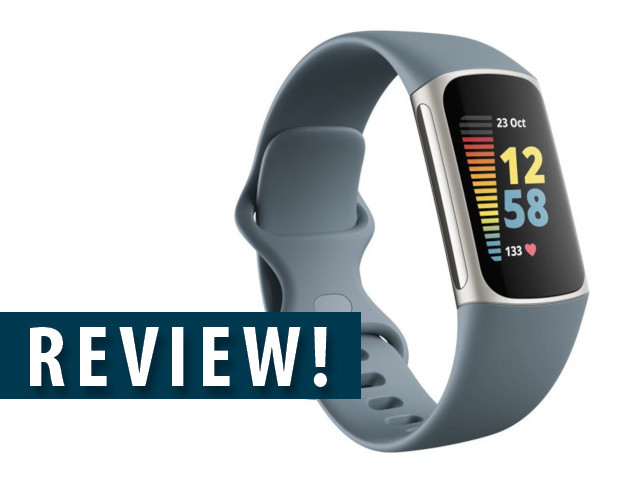FULL DISCLOSURE: The Fitbit Charge 5 was received from Fitbit as a seeding unit and not returned.
Fitbit’s Charge series has always been a convenient way to get much of the features of their Versa smartwatches in smartband form. The Charge 5 does the same but actually includes functionality not found on some of the other smartwatches, including EDA scan and ECG functionality, only featured on the top-end Fitbit Sense.
Importantly, the Charge 5, with its extras, comes in at just below R4k, with the Versa 3 (review), arguably lesser specced, retailing at R4 800 and the flagship Sense smartwatch at R6 800.
Usage and design
Fitbit does the basics well, and if you expect great sleep tracking, heart rate monitoring and step tracking, the Charge 5 doesn’t disappoint. The company is good at providing this info in an easy digestible fashion on its app. Yes, you don’t always know where to change certain functionality (is it on the watch or app?) but you’ll always find your information well displayed and easy to access.
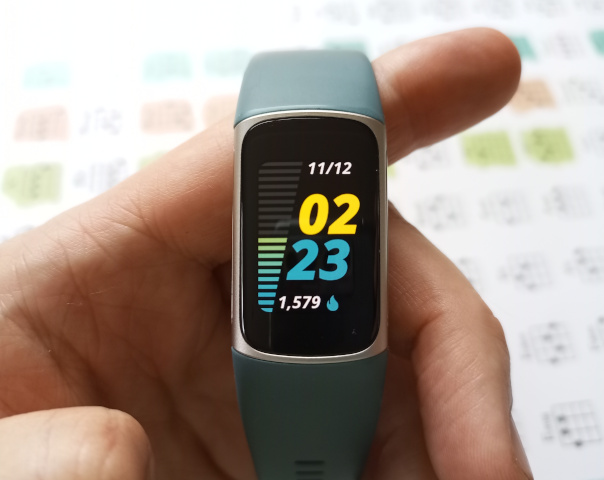
If you are looking to upgrade from the Charge 4 (or even the Versa 3), Fitbit provides decent motivation to do so. With a smoother design, the Charge 5 does away with the button on the side, providing only touch to work with. I particularly enjoyed the stainless steel case, providing a more premium feel to the device and it’s a definite step up to other smartbands on the market. My favourite colour for the plastic strap is the new steel blue, with black or white regulars also available. Although the case itself looks great, Fitbit missed a trick by not offering a more tapered strap seeing that the case and plastic band is of similar width.
The new OLED display on the Charge is a big plus from the Charge 4, viewable on runs even in the bright Joburg light. While the display looks quite large, the actual screen (1.04”, 326 ppi) does not take up all the real-estate. It’s a bit of a shame since the Charge 5 could have done with a bit of extra screen space - handy on runs or exercise where certain text is difficult to read. When it comes to about the perfect size for a smartband, the Huawei Band 6’s larger 1.47” Amoled (282 ppi) still reigns supreme in my opinion.
The Sense 5 is a complete touch-screen experience, swiping up and down, left and right for different menus and options. Personally, I do love a physical button on the side, but taking into account the added sensors on the side (needed for EDA and ECG) this is not possible on the Charge 5. While at home I had little problems with the touchscreen (maybe missing a swipe here and there), on the road running this becomes more of a headache, especially with sweaty fingers.
Battery life is impressive for a Fitbit, standing on seven days according to the company. I achieved a solid six days with the always-on set to off and two exercise routines using the GPS.
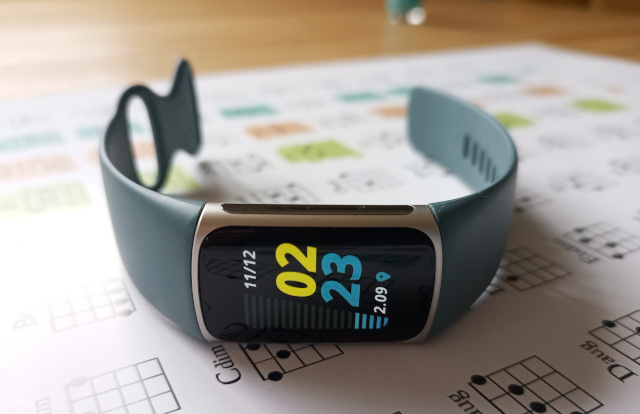
(Smart) Band on the Run
The GPS system on the Charge 5 has caused some controversy, with DC Rainmaker noting that he had to choose between good reception or heart rate monitoring. Out on runs, the Charge 5’s fit was comfortable and I did not have a similar experience on a number of runs, receiving good heart rate and GPS tracking (there was one run where the Charge simply did not connect to the GPS satellites for the duration of the run).
One thing missing from the Charge 5 is an Altimeter, which means it doesn’t measure your elevation gain during a run, nor the amount of floors climbed during the day. If you have linked your Fitbit to Strava, they will automatically provide elevation gain for your runs.
This time round Fitbit provides the ability to choose an always-on display for your activities, meaning you’re not dependent on lifting your arm correctly to see your stats.
While running, in order to scroll through your different stats (pace, pace avg, heart rate, calories, steps, actual time, distance, time, lap, zone min), you have to tap the screen. It’s difficult to continually do so while running, and it also happened that I activated the pause screen by accident and then had to swipe to go back.
It’s a LOT of stats to tap through, and Fitbit doesn’t provide the ability to adjust the amount of stats you require (as on the Versa 3). Distance and time are luckily always on display on the top and bottom, although very small.
You also need to tap the screen to move away from your most recent lap time, even if well into the next lap already. Ditto for the Activity Minutes pop-up, and any phone call that came in through your phone while running with it. It’s these small niggles that makes me wonder how much real-world feedback Fitbit takes into account when looking at the fitness tracking side of things.
There’s also a few tricks Fitbit missed. For example, Huawei provides a nice extra by telling you if you’ve just completed your best 5km time for example. Your stats after a run is also provided in a colour coded fashion. Even with the new colour OLED, Fitbit provides monocolour info on your run that is boring to look at, difficult to discern and which stays there until you press “Dismiss” to go back to the regular display.
To get to your Exercise screen you have to scroll past Notifications first, with no way to change which screens are displayed in what order. And Fitbit still does not offer a way to see your exercise history on the smartband itself, even if you want to quickly check your earlier run.
As mentioned when reviewing the Versa 3, if you are starting to get serious about running, the Charge 5 does not fit the bill.
Health and well-being
On the health side the Charge 5 makes a few interesting additions. Much like the Versa 3 you have a temperature sensor and SpO2 monitoring sensors onboard, although these only do so for night time only, with this info to be found under the Health Settings tab on the app. Seeing that these stats seem quite important, it would have been better if Fitbit somehow provided a way to track this manually during the day too.
Nonetheless there’s a lot of stats being tracked through your Charge 5, and Fitbit provides a weekly report that contains stats as compared to the previous week, such as an increase in resting heart rate, activity minutes, sleep or days of exercise. If you are a Fitbit premium member (there’s a six months subscription provided for free with the Charge 5), you are also allowed a Wellness report request, downloadable as a PDF, that contains visualisations and stats of your health trends relating to heart rate, weight, activity and sleep of the past year.
New to the Charge 5, but also available for certain other recent Fitbit models, is a Daily Readiness score. This incorporates your sleep data, heart rate variability and exercise records to tell you if your body requires a bit more recovery today, or if you can go ahead and stack up the miles. It’s reminiscent of Garmin’s Body Battery energy monitor which basically does the same.
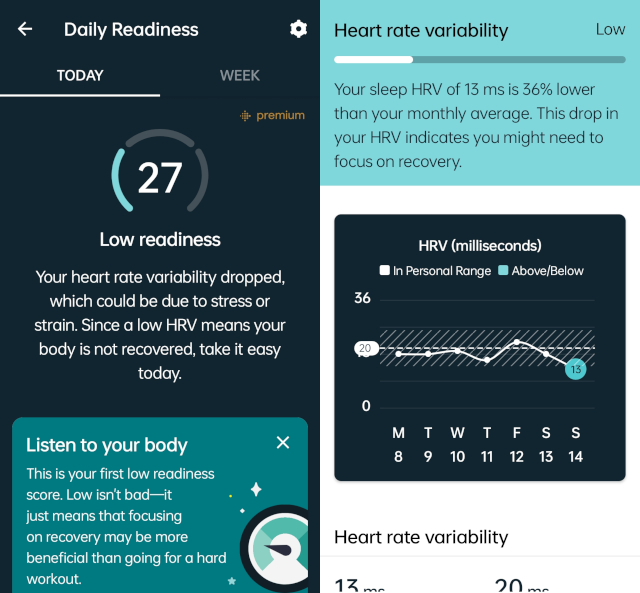
Fitbit requires four days with the Charge 5 on your wrist for your score to start reflecting your score. My four days of history came off the back of a bit of flu, with no active Zone minutes measured, an elevated heart rate and a disrupted sleep cycle. My first Daily Readiness score stood at 100%, which reflects perhaps the position that Fitbit’s algorithm doesn’t include the possibility of illness. However, the second day stood at a low 27, resulting from a drop of 36% in heart rate variability. Fitbit measures this during the night, pointing out that a lower HRV, “suggests the nervous system is stressed or devoting energy to recovery”. The following two days were up again to 98, while I’m still on the backend of the flu and not quite ready to take to the road for a run.
Fitbit notes another 14 days worth of measurement is required to fine-tune the daily readiness score. One could make the case that for many Fitbit users, a history of measurements are already available for the company to accurately predict this from the get-go, and could have provided an overall better score.
One concern is that you do need to be subscribed to Fitbit’s Premium membership for your Daily Readiness score. As mentioned, you do get six months free with the Charge 5, after which you will have to pay a rather hefty R170 per month (or R1350 per year). As a premium member, you receive extra stats such as a 30 or 90 day comparison of your health metrics, a stress management score, plus a more in depth breakdown of your sleep score breakdown.
It’s difficult to justify the Premium membership, seeing that you’re paying R4k for your device and then extra for data analysis on data which, in theory, belongs to you. Fitbit does provide extra workout videos and mindfulness videos, for which an extra fee could be justified.
ECG and EDA
New to the Charge 5 is the ECG app, where you hold the side of the watch for 30 seconds in order to check your heart rhythm. After a quick second of analysis, the Charge 5 will note either a normal sinus rhythm, or if you show signs of Atrial fibrillation, for which you should contact your doctor. It’s a quick test to get done, with this feature best appreciated by people who might suffer from AFib and need to check regularly. A PDF is available from the app to export to your doctor if need be.
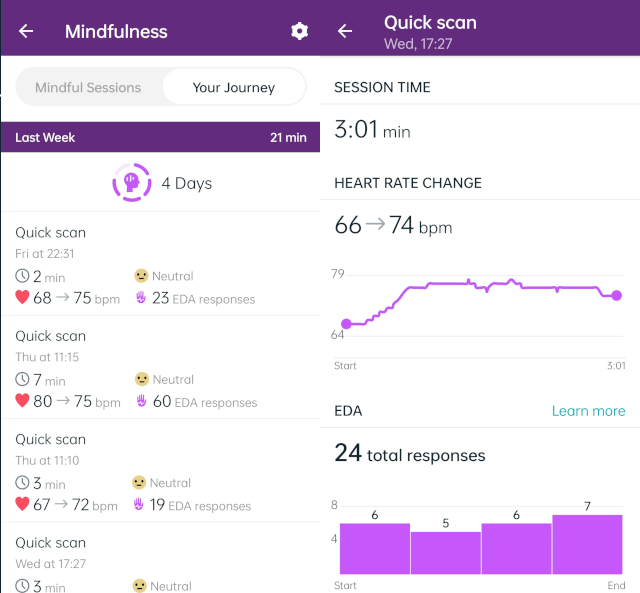
The EDA/Mindfulness tab on the app
An EDA scan works the same way, and here you can pick 2-7 minutes of holding the sides to receive a score. This detects the electrodermal activity responses on your skin to provide a score, with fewer EDA responses the calmer you are. For some reason Fitbit logs this as a Mindfulness session and also doesn’t use your EDA to determine the daily Stress Management score. Ultimately I could quite find value in this and did not bother with EDA after a while.
Overall
The Fitbit Charge 5 is an impressive smartband that, like most other Fitbit devices, provides accurate heart rate tracking, step counting and sleep tracking. While the OLED screen could have been slightly larger, the stainless steel design elevates it above the (plastic) opposition. It is encouraging to see the company offer features found on its flagship Sense smartwatch to the Charge category, including ECG and EDA, although mileage will vary on how useful these are to you.
The Charge 5 is not perfect, and Fitbit could do well to have a look at what Huawei is offering in terms of the fitness side of things.
I’m hopeful that Fitbit would still be able to improve on some of the overall useability of the Charge 5 through firmware updates (for example being able to pick in which order screens are displayed). It has done so in the past, with the most recent update fixing a minor bugbear - the EDA scan now buzzes after the timer has run out.
New additions, such as the Daily Readiness score, could also be useful to help you keep more in touch with your body overall wellbeing, that is if you remain a Fitbit Premium member after your six-months free trial ends.
The Fitbit Charge 5 retails for R4k and is available in stores now.
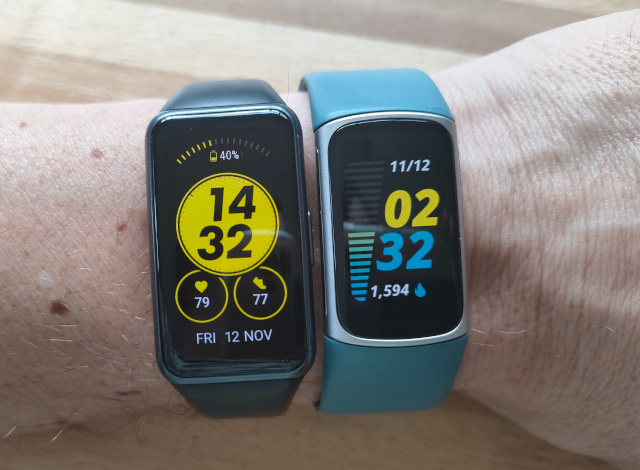
The Huawei Band 6 vs Fitbit Charge 5 size comparison

